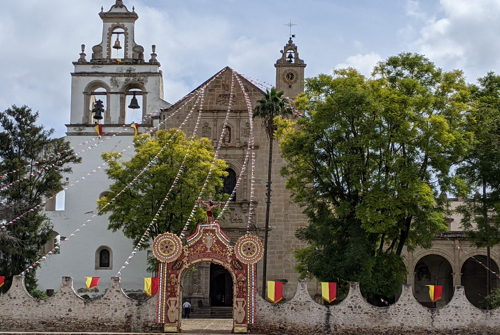Cuitzeo is another lovely Pueblo Mágico located just north of Morelia.
Located on the northern shore of Lake Cuitzeo, the town of Cuitzeo del Porvenir is a charming place to spend some time. Easily accessible by car or bus from Morelia in 30 minutes, it offers visitors a laidback and relaxed destination in which to explore the impact of the Spanish rule over indigenous Mexican people.
The Catholic Church spared no expense in creating imposing churches for the newly-converted. From the paintings, statues, and other decorative elements, to the bell towers, pipe organs, and welcoming plaza, it was designed to awe and impress.
Like all Spanish colonial cities, the central plaza is the physical and spiritual center of the town. A main street lined with small shops and businesses runs along one side of the plaza, but the other three sides are bordered by churches.
To the north, is the Shrine of Our Lady of Guadalupe, a small church filled with images of Guadalupe and Juan Diego, the man to whom Guadalupe appeared in 1531 (in what is today's Mexico City) requesting the dedication of a shrine. Our Lady of Guadalupe (Nuestra Señora de Guadalupe in Spanish) is Mexico's patron saint.
To the southeast of the plaza is the Templo del Hospitalito, a small chapel from the colonial era, lovingly maintained. The floor is of rubbed-smooth wooden beams, and the walkway to the entrance is flanked by orange trees.
But it is to the east that we find the principal church of Cuitzeo, the Parish of Mary Magdalene. Once you enter through massive carved door, you encounter a massive vaulted space ringed with decorative frescos and a splash of blue paint. In the choir loft is a compact organ, whose lower pipes have faces incorporated thereon.
Attached to the Parish of Mary Magdalene, but completely separate from it, is the Antiguo Convento de Santa María Cuitzeo. Usually, English speakers equate a "convent" with a "nunnery," but in Mexican Spanish, the term 'convento' refers to any place of Catholic religious orders, whether for men (sacerdotes, or priests) or for women (monjas, or nuns). In Cuitzeo, the Convento housed men studying for the priesthood. There within the cloisters they pursued lives of reflection, study, and devotion, away from the temptations of the secular world outside.
Fortunately, the ex-Convento is open to visitors as the Museo de la Estampa. The entrance fee is $65 pesos (approximately $3.25 USD), although the museum is free on Sundays. Within are exhibits documenting pottery, jewelry, and other objects discovered in excavations at the site. However, the most compelling aspect of the museum is the opportunity to explore the inner world of the convento, including meeting and sleeping rooms, bathing facilities, and a secret space that allowed the residents to observe mass in the church without being seen by the public. Highly recommended!
Just south of the ex-Convento is a peaceful botanical garden that offers shady paths for strolling, a fountain, public bathrooms, and the children's library.
The main plaza is anchored, like nearly all Spanish colonial towns in Mexico, by a bandstand (kiosko) in the center. The plaza is ringed with vendors selling food and snacks, artisanal crafts, and clothing.
A visit to Cuitzeo makes for an easy and enjoyable day trip from Morelia!

